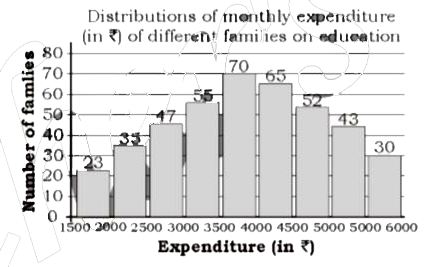What is the ratio of the number of families whose monthly expenditures on education are below ₹2,500 to the number of families whose monthly expenditures on education are ₹4,000 or above but less than ₹6,000?
21:31
21:32
16:23
29:95
The correct Answer is:B
To solve the problem, we need to find the ratio of two groups of families based on their monthly expenditures on education. Let's break it down step by step:
Step 1: Identify Families with Monthly Expenditures Below ₹2,500
From the bar graph, we need to find the number of families whose expenditures are below ₹2,500. According to the video transcript, we have:
- 35 families with expenditures between ₹1,500 and ₹2,000
- 23 families with expenditures between ₹2,000 and ₹2,500
Now, we add these two numbers together:
Total families below ₹2,500=35+23=58
Step 2: Identify Families with Monthly Expenditures Between ₹4,000 and ₹6,000
Next, we need to find the number of families whose expenditures are ₹4,000 or above but less than ₹6,000. The relevant data from the bar graph includes:
- 65 families with expenditures of ₹4,000
- 52 families with expenditures of ₹4,000 to ₹5,000
- 43 families with expenditures of ₹5,000 to ₹6,000
- 30 families with expenditures of ₹6,000 (but we only consider up to ₹6,000)
Now, we add these numbers together:
Total families between ₹4,000 and ₹6,000=65+52+43+30=190
Step 3: Calculate the Ratio
Now that we have both totals, we can find the ratio of families whose expenditures are below ₹2,500 to those whose expenditures are between ₹4,000 and ₹6,000:
Ratio=Families below ₹2,500Families between ₹4,000 and ₹6,000=58190
Step 4: Simplify the Ratio
To simplify the ratio 58190, we can divide both the numerator and the denominator by their greatest common divisor (GCD). The GCD of 58 and 190 is 2.
58÷2190÷2=2995
Thus, the simplified ratio is:
Ratio=29:95
Final Answer
The ratio of the number of families whose monthly expenditures on education are below ₹2,500 to the number of families whose monthly expenditures on education are ₹4,000 or above but less than ₹6,000 is:
Final Answer=29:95
---
From the bar graph, we need to find the number of families whose expenditures are below ₹2,500. According to the video transcript, we have:
- 23 families with expenditures between ₹2,000 and ₹2,500
Next, we need to find the number of families whose expenditures are ₹4,000 or above but less than ₹6,000. The relevant data from the bar graph includes:
- 52 families with expenditures of ₹4,000 to ₹5,000
- 43 families with expenditures of ₹5,000 to ₹6,000
- 30 families with expenditures of ₹6,000 (but we only consider up to ₹6,000)
Now that we have both totals, we can find the ratio of families whose expenditures are below ₹2,500 to those whose expenditures are between ₹4,000 and ₹6,000:
To simplify the ratio 58190, we can divide both the numerator and the denominator by their greatest common divisor (GCD). The GCD of 58 and 190 is 2.
The ratio of the number of families whose monthly expenditures on education are below ₹2,500 to the number of families whose monthly expenditures on education are ₹4,000 or above but less than ₹6,000 is:
Similar Questions
Study the graph and answer the question

What is the ratio of the number of families whose monthly expenditures on education are below Rs 3000 to the number of families whose monthly expenditure on education are Rs 4000 and above less than Rs 5500.
View SolutionStudy the graph and answer the question

The number of families whose montly expenditures on education are Rs 2000 or more but less than Rs 4000 is
View Solution
Knowledge Check
Study the graph and answer the question:

The number of families whose monthly expenditures on education are ₹2,500 or more but below ₹4,000 is what percentage more than the number of families whose monthly expenditures on education are ₹4,500 or more but below ₹6,000?A37.6B27.3C29.8D36.4The ratio of monthly incomes of A, B is 6 : 5 and their monthly expenditures are in the ratio 4:3. If each of them saves Rs 400 per month, find the sum of their monthly incomes.
A2300B2400C2200D2500
Study the graph and answer the question

the number of families whose montly expenditures on education are Rs 2500 or more but less than Rs 4000 is what percentage more than the number of families whose monthly expenditure on education are Rs 4500 or more but below Rs 6000.
View SolutionStudy the graph and answer the question.

The number of workers in the factory whose weekly earnings are below Rs. 7,000 is what percentage more than the Number of workers whose weekly earnings are Rs. 7,000 or above but less than Rs. 8,500?
View SolutionUse the data in following table that relate to monthly household expenditure (in Rs.) on food of 50 households, and
(i) Obtain the range of monthly household expenditure on food.
(ii) Divide the range into appropriate number of class intervals and obtain the frequency distribution of expenditure.
(iii) Find the number of households whose monthly expenditure on food is
(a) less than Rs. 2,000, (b) more than Rs. 3,000, (c) between Rs. 1,500 and Rs. 500.

View SolutionThe monthly expenditure of a family o 9 members is Rs 891. What will be the montly expenditure of the family, if there are 12 members?
View SolutionThe monthly expenditure of a family o 9 members is Rs 891. What will be the montly expenditure of the family, if there are 12 members?
View SolutionThe ratio of income to expenditure of a family is 7 ,What is the income of the family,if its expenditure month is 228,000 ?
View Solution
